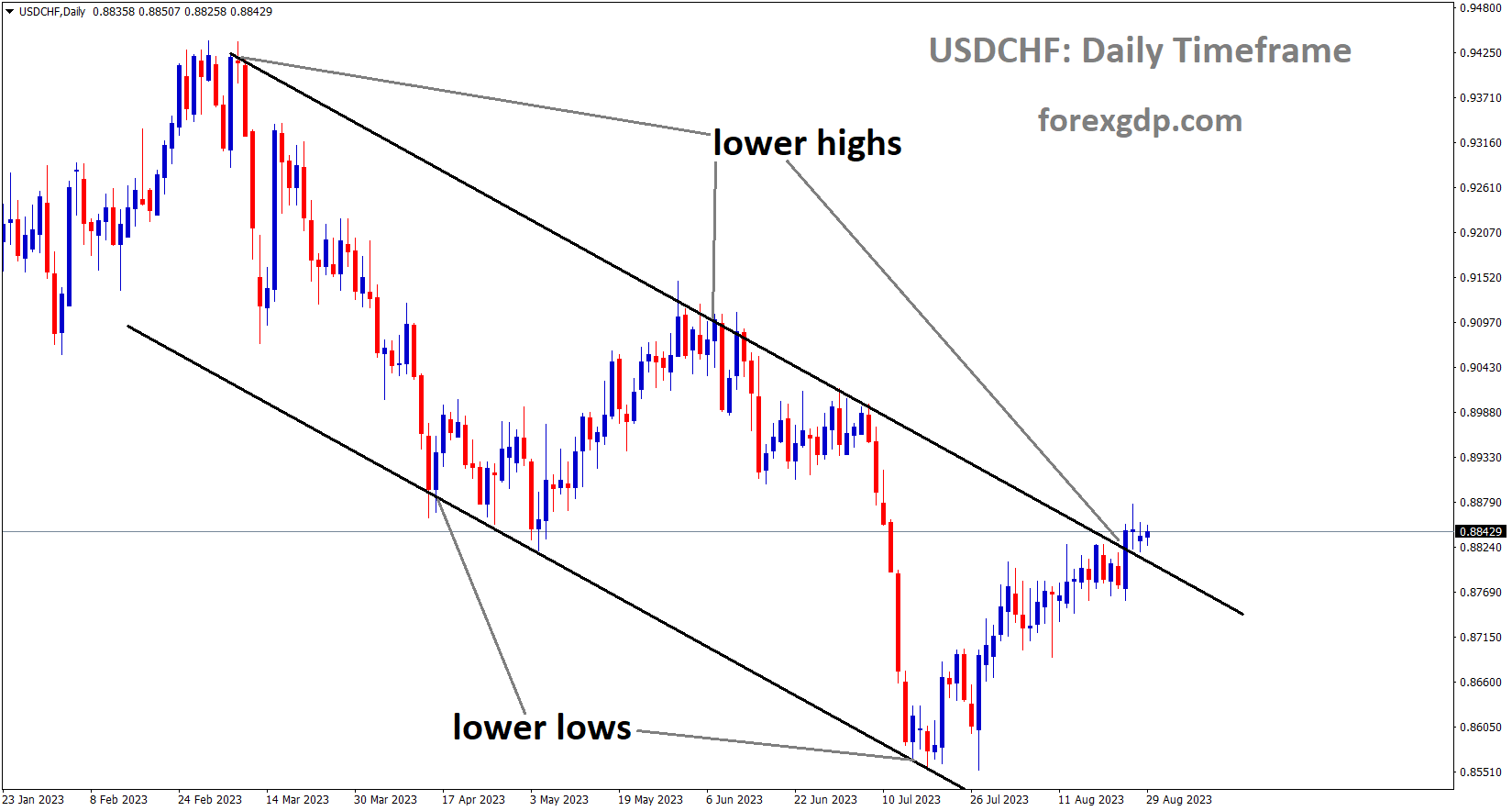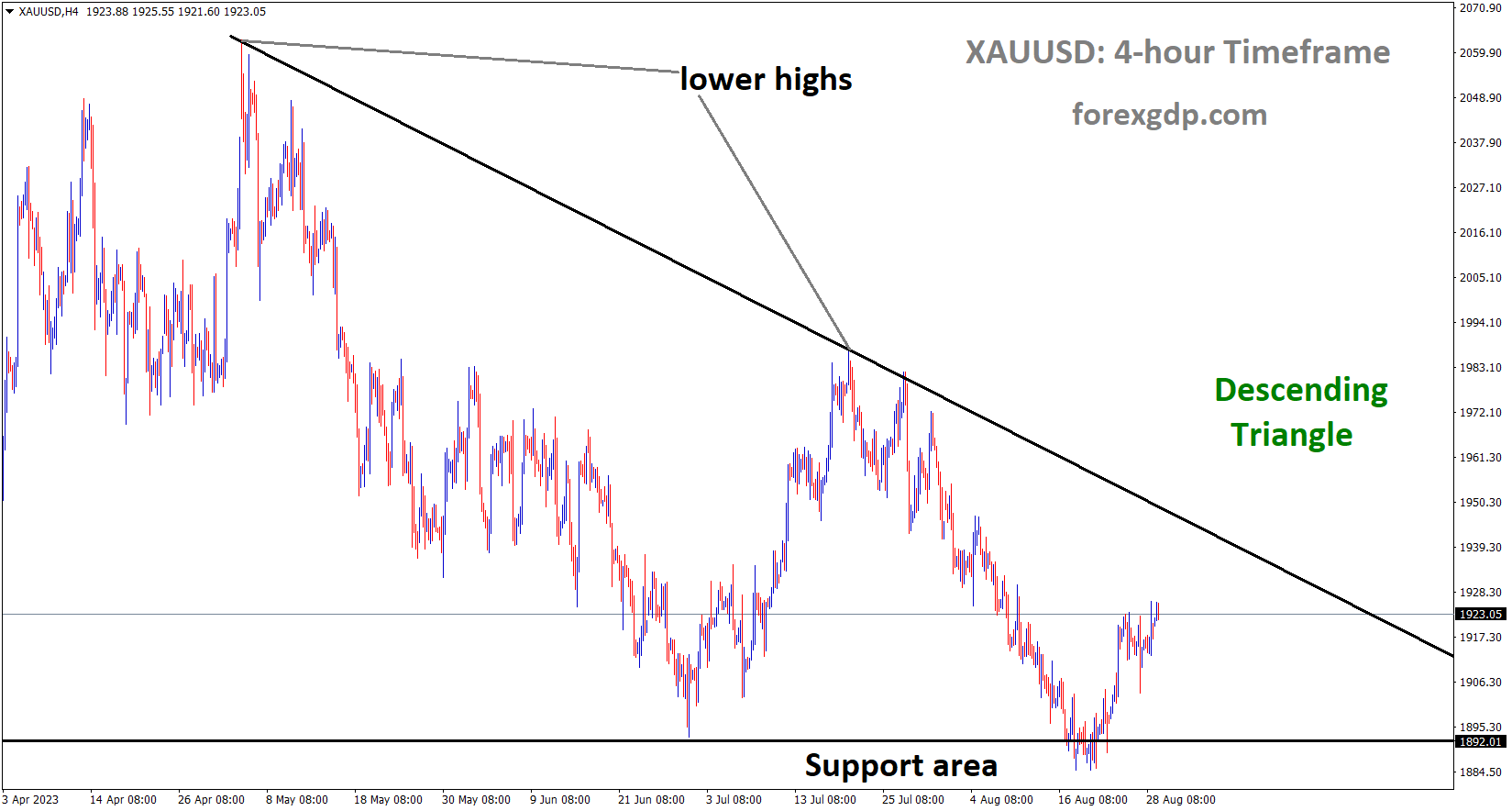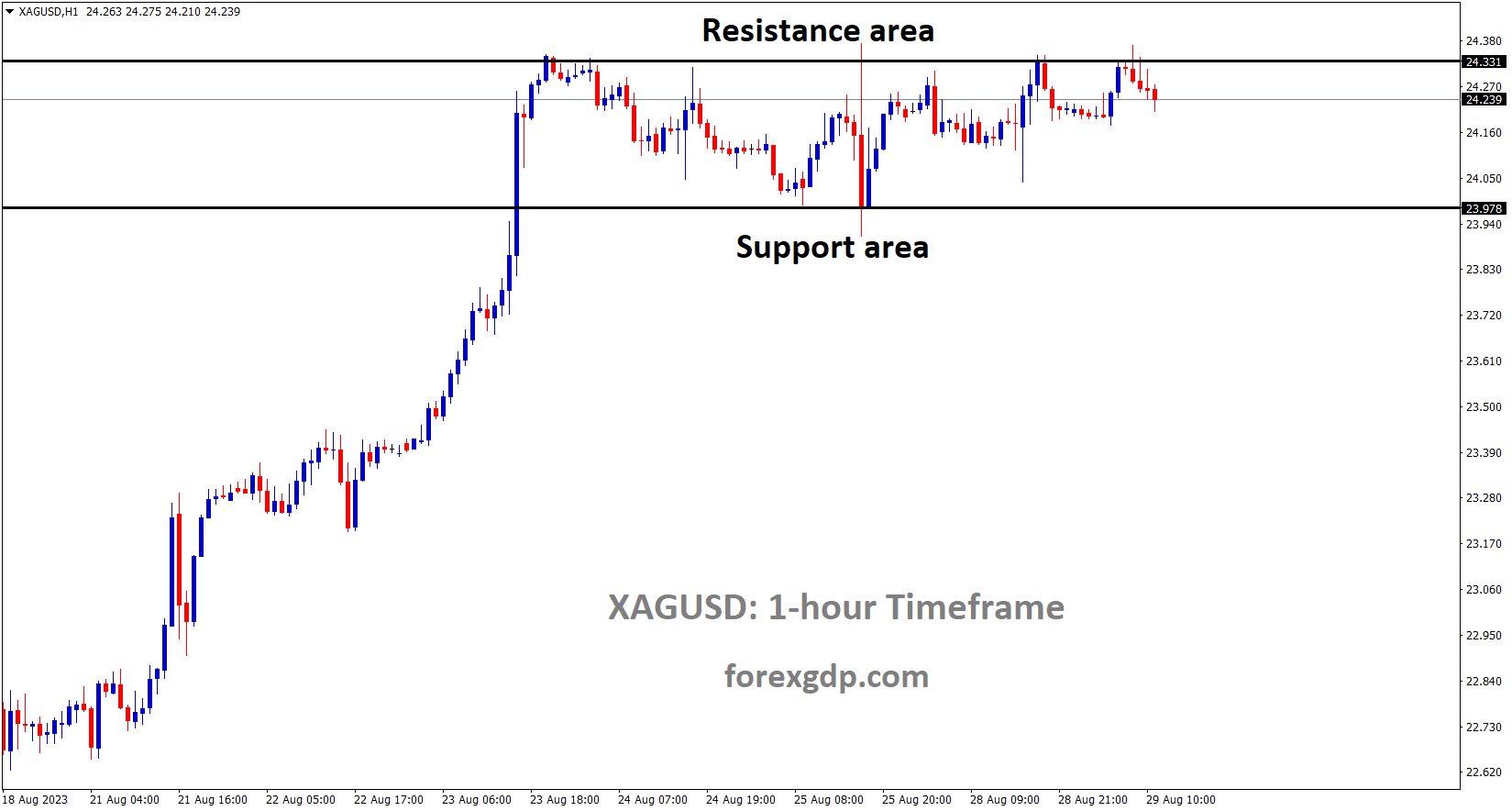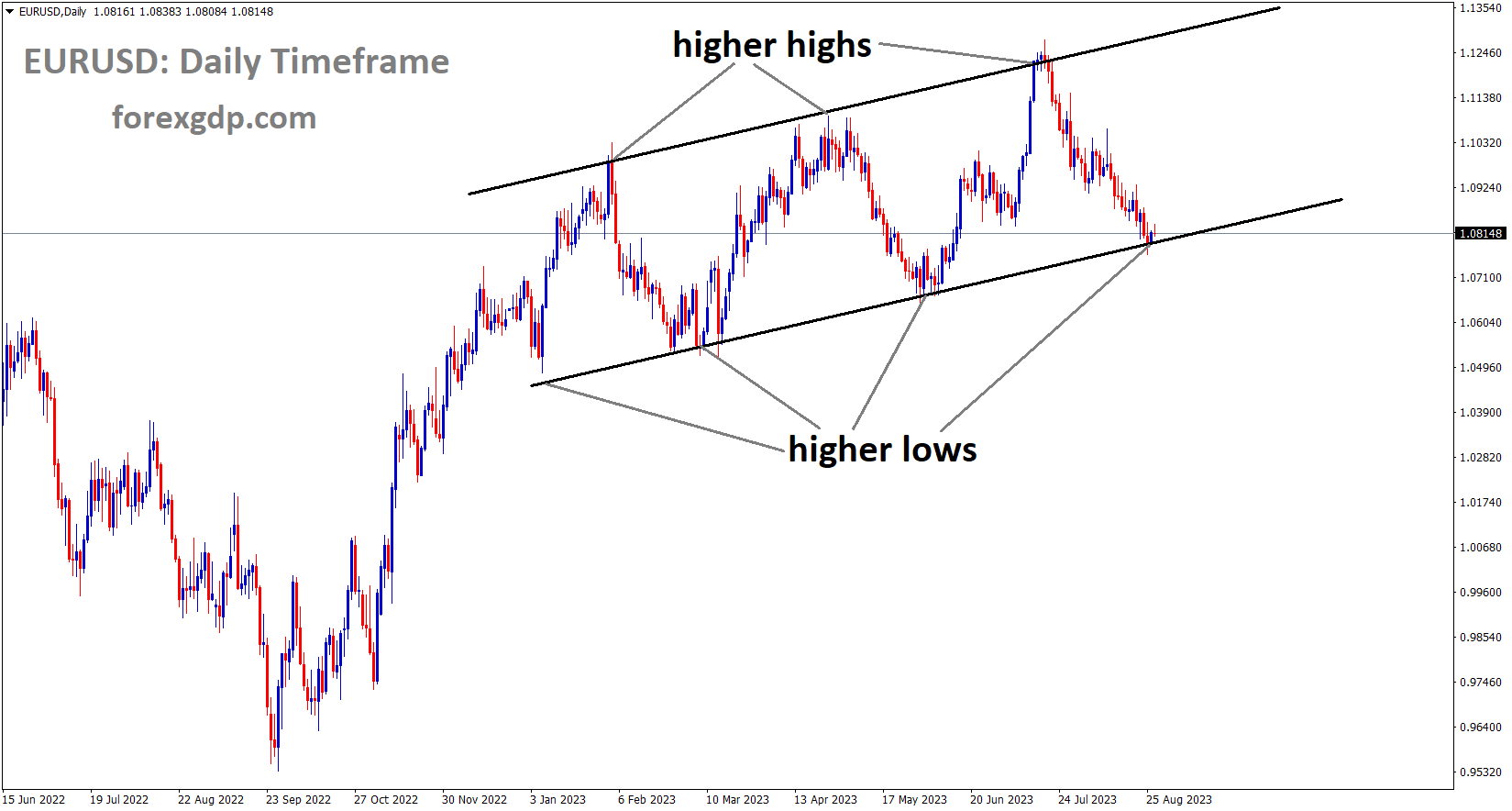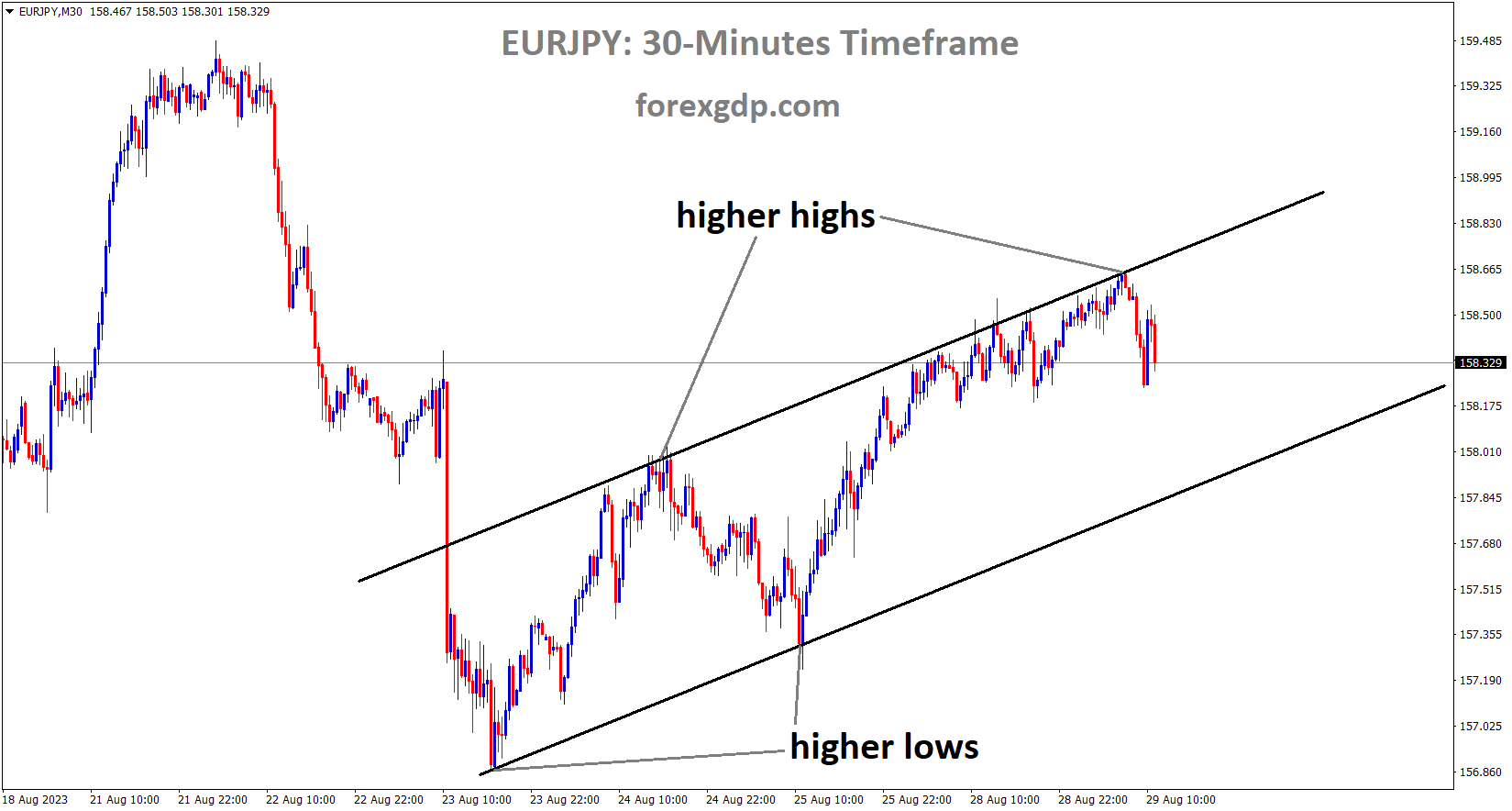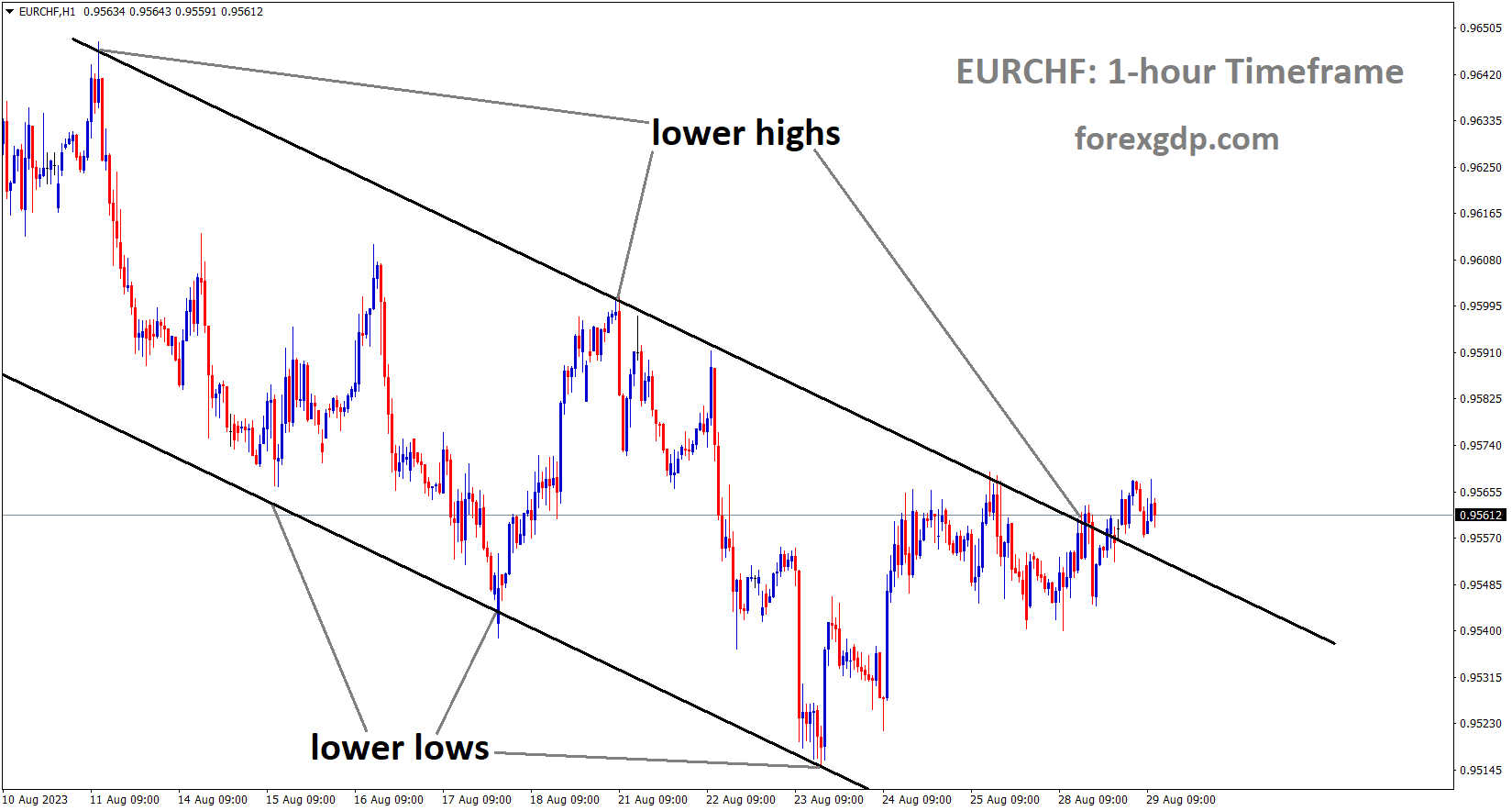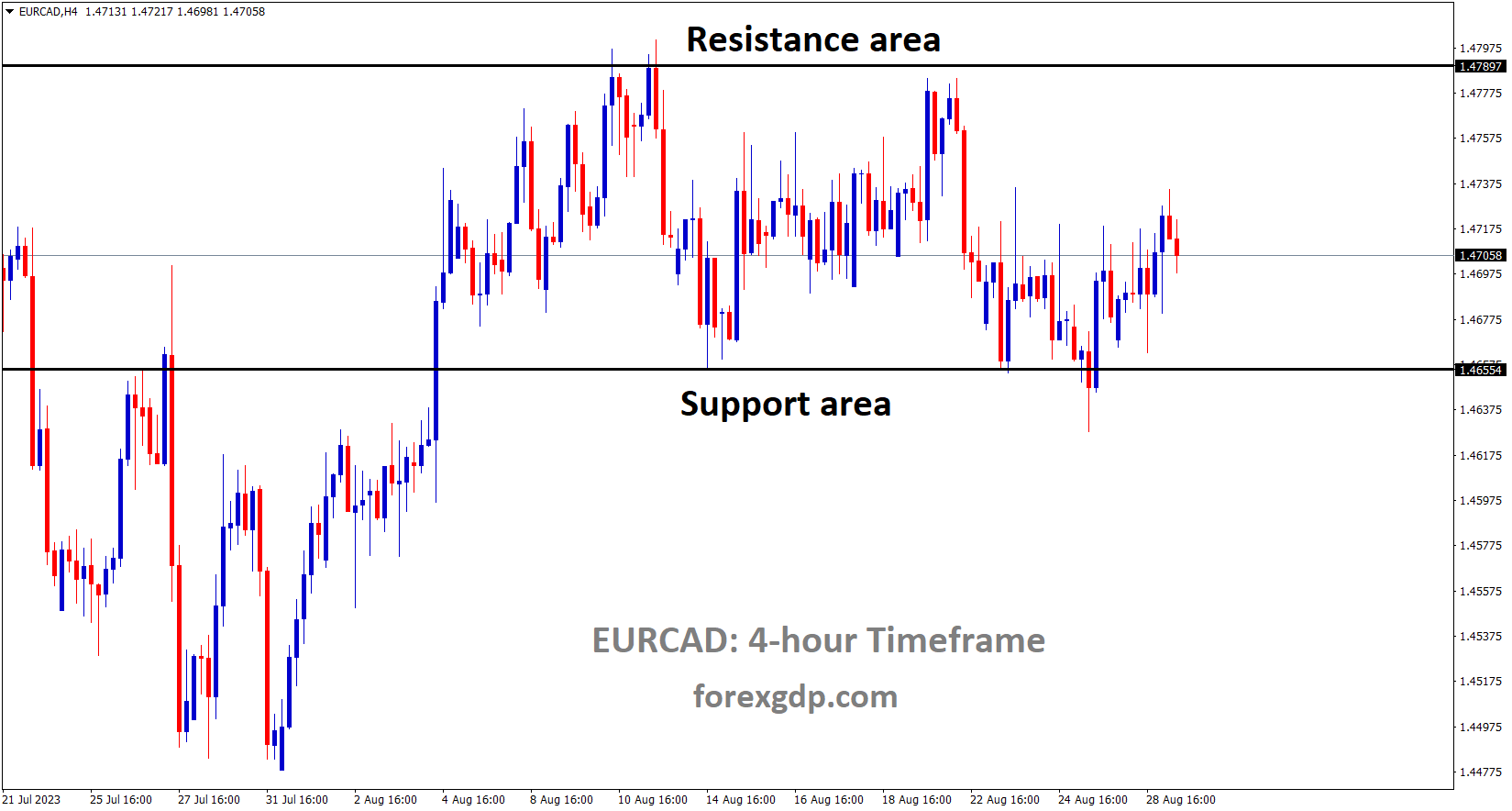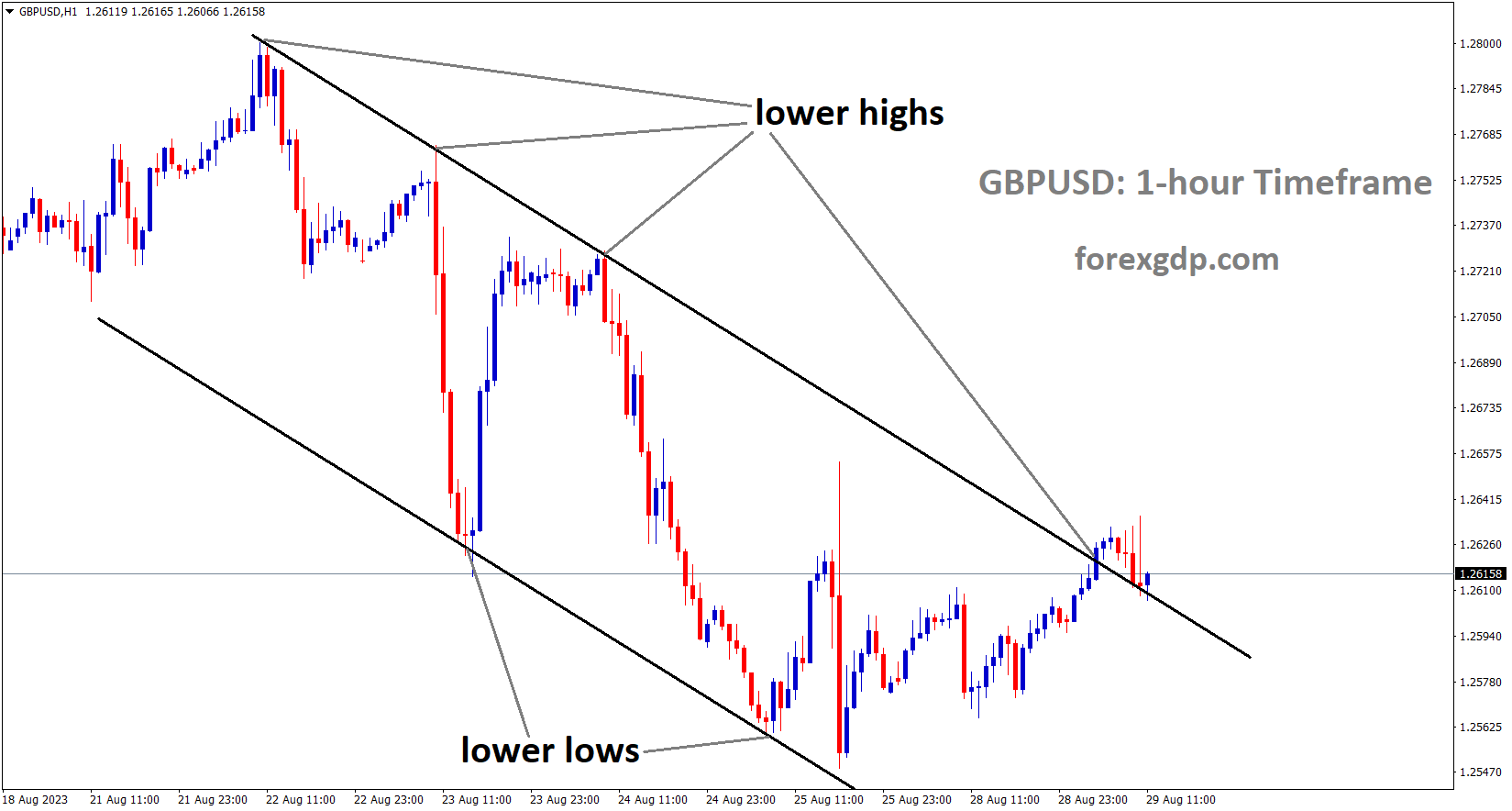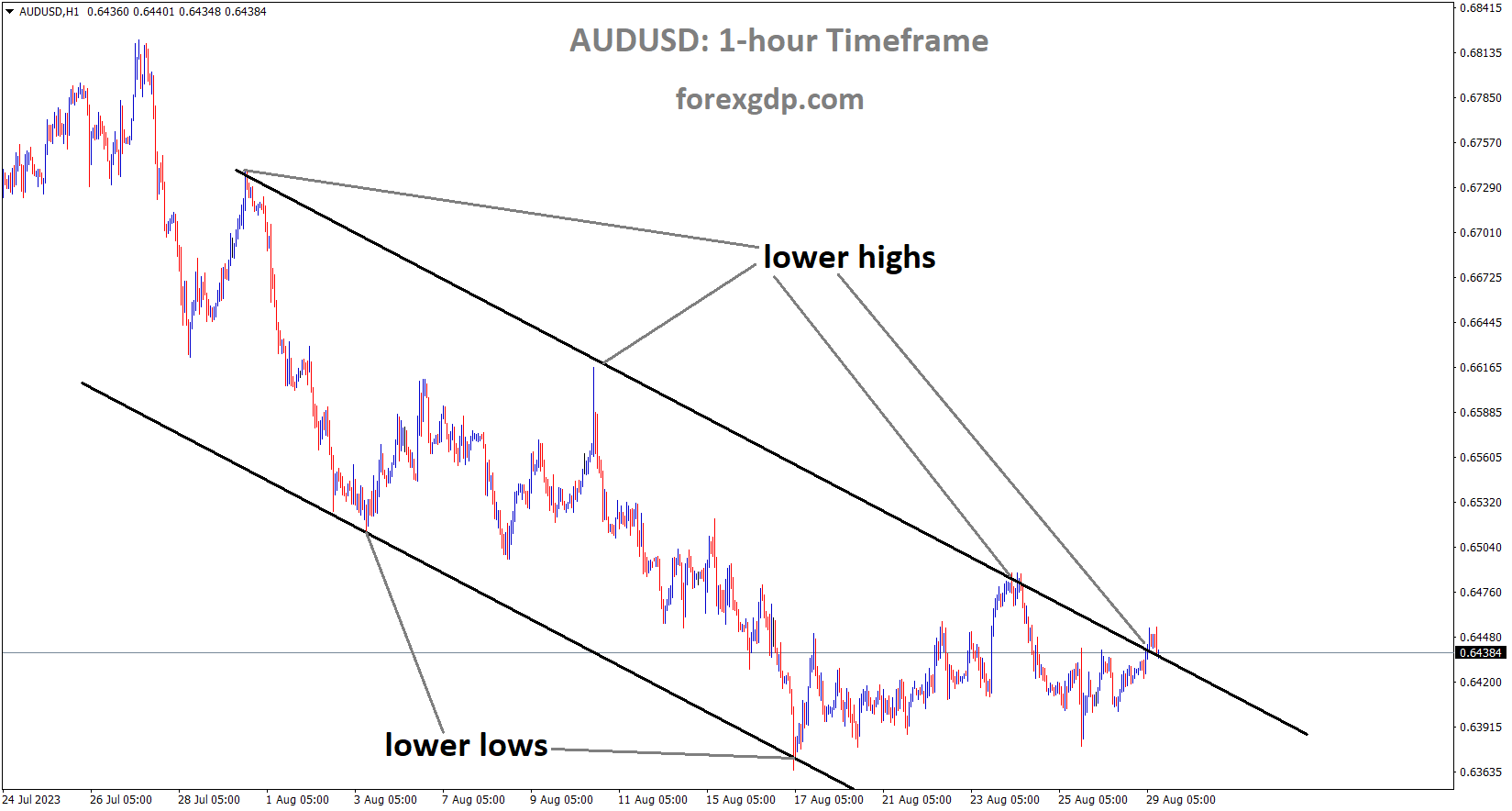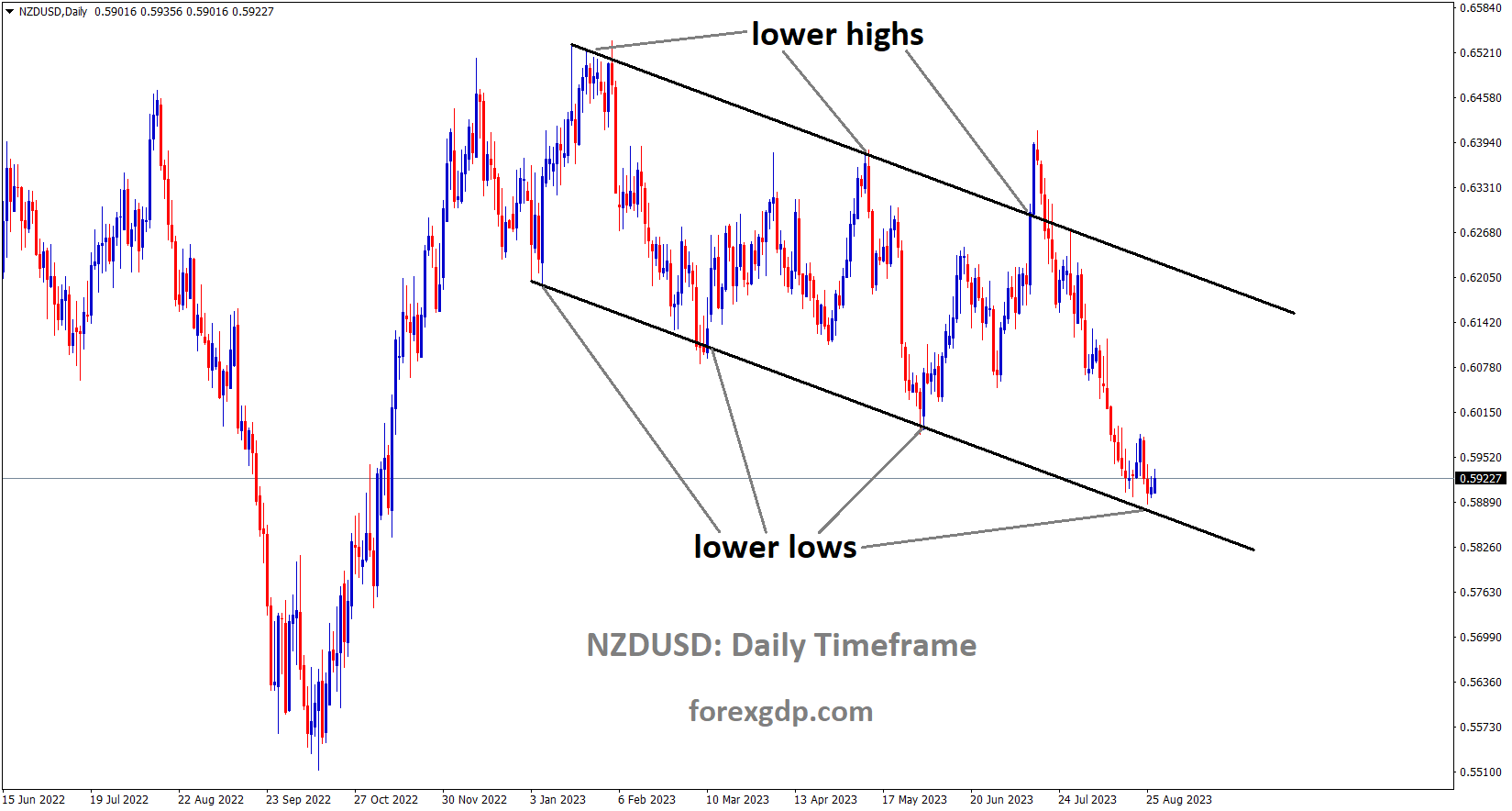USDCHF Analysis
USDCHF is moving in the Descending channel and the market has reached the lower high area of the channel
The US dollar increased following the FED Powell stated that further tightening of monetary policy is necessary to lower the rate of inflation.
The USD increased versus counter pairs last week as domestic data came in higher than anticipated.
After US Federal Reserve Chair Jerome Powell warned of further tightening to bring inflation down to the 2% target, the US dollar is holding gains against its peers, particularly if the recent uptick in activity puts upward pressure on prices. US Federal Reserve Chair Jerome Powell generally maintained a slightly hawkish tone while speaking at the annual Jackson Hole Economic Policy Symposium, threatening more rate hikes if inflation stays too high. Powell did, however, acknowledge that price pressure has moderated and stated that the Fed will carefully consider whether to tighten further.
Powell stated that above-trend growth might jeopardise future gains on inflation and call for additional tightening. The Economic Surprise Index is barely below a two-year high, despite the overwhelming strength of US economic data in recent months. The positive recent trends in retail sales, housing starts, and industrial production indicate that the current quarter’s activity has picked up. To learn more, see “US Dollar Toppish.” Prior to Powell and the markets are now pricing in a roughly 50% chance, up from 33% a week ago, of a 25 basis point hike by the Fed at its meeting in November. The US core PCE, jobs data, and manufacturing and services activity are currently the main areas of focus. Expectations of a rate hike in November may be lowered if there are any indications of a slowdown in activity or price pressures.
XAUUSD Analysis
XAUUSD is moving in Descending Triangle and market has rebounded from the support area of the pattern
Gold prices have stabilised versus the US dollar following FED Powell’s powerful but eloquent speech on Friday.
Gold moved this week ahead of the NFP and the unemployment rate, based on the released data.
As the U.S. dollar weakened due to declining Treasury yields, gold prices saw a slight increase at the beginning of this week. However, larger movements were constrained by reduced liquidity because U.K. markets were closed for the Summer Bank Holiday. XAU/USD was up roughly 0.50% to $1,924 in early afternoon trading. It was consolidated above its 200-day simple moving average and was moving closer to technical resistance at $1,925–$1,930, which could impede the nascent recovery. Regarding the future, the Federal Reserve has promised to proceed cautiously after delivering 525 basis points of cumulative tightening since March 2022 in its most aggressive hiking cycle in four decades, so the precious metal will be extremely sensitive to any incoming U.S. economic reports.
XAGUSD Analysis
XAGUSD Silver price is moving in the Box pattern and the market has fallen from the resistance area of the pattern
The data-dependent approach is a component of a plan to maintain maximum flexibility in the event that future meetings require the central bank to implement further tightening of monetary policy in order to contain high inflation, which picked up speed early in the summer and is still well above the 2.0% target. Traders should pay close attention to the release of the August U.S. nonfarm payrolls NFP report, which is scheduled for release on Friday. This report is expected to offer important insight into the outlook and inform the FOMC’s decision-making process. Expectations state that U.S. employers hired 187,000 workers in July, and they will add 170,000 this month. On the other hand, the unemployment rate appears to be remaining stable at 3.5%, indicating ongoing tightness in the labour market.
EURUSD Analysis
EURUSD is moving in an Ascending channel and the market has reached the higher low area of the channel
This week’s euro area Flash CPI data is expected to inform the ECB’s September rate hike decision. The Euro Area’s poorest performance, according to PMI data, raises concerns about a recession there. The worst performance is seen across all sectors when the ECB hikes rates further; therefore, a pause in rate hikes is more likely in the upcoming meetings.
The recent releases of European data have been concerning, to put it mildly, with the PMI data from last week further fueling fears of a recession as rate hikes start to bite into the economy. A number of industries experienced a slowdown according to the PMI data, but input costs appeared to be starting to rise again. The Euro Area is now more susceptible to additional rate increases due to the acceleration of price pressure, which would undoubtedly cause the region to enter a recession. Both ECB policymaker Martin Kazaks and President Christine Lagarde expressed similar concerns about price pressure during their Jackson Hole addresses, saying that a pause now could have longer-term effects later on. As it stands, the September meeting is in a precarious position, with a 50/50 chance of another 25 bps hike.
This week’s releases from the US, the UK, and the Euro Area are light from a risk event standpoint, but each one could have an impact on the EURUSD. This week, the Euro Area will release its most recent inflation flash estimates, which may serve as a crucial roadmap for the European Central Bank’s (ECB) September meeting decision. The ECB’s decision to raise rates once more now rather than waiting any longer may be reinforced by any indication that inflation is starting to move higher or that the steady decline may be slowing down. Theoretically, this should give the Euro some strength, though it might face pressure based on the data that its rivals release. As previously noted, there are a lot of releases coming from the US, but the two most important ones are probably the NFP jobs data and the US Core PCE data, which is the Fed’s preferred inflation measure. The US economy has been robust because of consistent demand, with a significant contribution from average hourly wages. A rise in PCE could give the US dollar some support, and should such a print occur, we might see some hawkish repricing of the Fed Funds peak rate.
EURJPY Analysis
EURJPY is moving in an Ascending channel and the market has fallen from the higher high area of the channel
The Japanese government published an outlook for economic growth for August in which it noted increased business investments and private consumption. The government expressed satisfaction with corporate profits and industrial production figures. Thus far, inflation has fallen short of our goal.
Following the Japanese government’s release of its updated Economic outlook this morning, the Yen sought to recover some of its losses. Subsequently, the Chinese authorities made additional efforts to support the economy, which resulted in a slight increase in risk-taking during the Asian session and negatively impacted the US Dollar. Overnight, the Japanese government released its monthly economic outlook report for August, not making any notable changes. The government observes a recovery in private consumption and encouraging signs in business investment. The government also expressed satisfaction with the overall moderate improvement in corporate profits and industrial production figures. Despite rising, consumer prices are still below the central bank’s target, necessitating an ultra-easing of monetary policy.
The cautious movements in JPY pairs that we have seen recently may be due to persistent concerns about Japanese authorities interfering in foreign exchange markets. These have historically arrived suddenly and have the ability to increase volatility.
According to Japanese Finance Minister Shunuchi Suzuki, additional economic measures will be implemented after September. At this point, an additional budget is not anticipated.
Shunichi Suzuki, the finance minister of Japan, stated on Tuesday that the government will think about implementing economic policies after September. He stated that at this time, he does not want to comment on the additional funding.
EURCHF Analysis
EURCHF is moving in the Descending channel and the market has reached the lower high area of the channel
According to the Swiss Competition Commission, they are investigating UBS’s acquisition of Credit Suisse and will report their findings to FINMA by the end of September.
The takeover of Credit Suisse by UBS is being investigated by Switzerland’s Competition Commission, the body announced on Monday. The two biggest banks in Switzerland merged in March as a result of a hastily negotiated rescue agreement for Credit Suisse by the government, central bank, and financial regulator.
The vice-director of the Swiss Competition Commission told Reuters, We confirm that the Commission is looking into the takeover of CS by UBS and will send FINMA her results probably by the end of September.
EURCAD Analysis
EURCAD is moving in the Box pattern and the market has rebounded from the horizontal support area of the pattern
In June, Canadian retail sales increased by 0.10% over the prior report. It is anticipated that the Canadian GDP will grow by 1.2% this week.
The Loonie is weakened by a drop in oil prices because Canada is the US’s top crude exporter. However, the encouraging move from China, the world’s largest oil importer, could strengthen the Loonie relative to its competitors. Having said that, in an effort to boost the capital market and boost investor confidence, Chinese authorities would lower the 0.1% duty on stock trading.
The month-over-month growth in Canadian retail sales for June was 0.1% last week. The result was higher than the predicted 0%. Investors will be watching Friday’s release of Canada’s annual Gross Domestic Product (GDP) data. A lower-than-expected growth rate would persuade the Bank of Canada (BoC) to keep interest rates at their current level of 5%. In the near future, traders will be monitoring the second quarter of the Canadian annual GDP. There is a 1.2% expected expansion in the growth number.
GBPUSD Analysis
GBPUSD is moving in the Descending channel and the market has reached the lower high area of the channel
According to data from the Britain Retail Consortium, annual shop price inflation increased to 6.9% in August from 7.6% in July. The expectation of a smaller rate hike has caused the GBP to decline.
The annual shop price inflation reported by the British Retail Consortium (BRC) for August flashed 6.9%, down from July’s 7.6%, and reached its lowest point since October 2022. It will be crucial to observe the British traders’ return to the negotiation table and their response to Bank of England (BoE) Deputy Governor Ben Broadbent’s hawkish stance from the previous week. Nevertheless, BoE’s Broadbent cited the need for higher rates at the Jackson Hole Symposium as a result of wage pressure; his economic outlook appears to contradict both the British Pound (GBP) optimists and the hawks.
AUDUSD Analysis
AUDUSD is moving in the Descending channel and the market has reached the lower high area of the channel
This week’s Australian CPI data is due; in July, it was 5.2%, up from 5.4% in June. The RBA paused the cash rate at two of its previous meetings, leaving it at 4.1%.
This period of time is maintained by China’s slowing economic growth and Australia’s contracting labour market.
In an effort to recover some of its recent losses ahead of crucial Australian inflation data that is expected on Wednesday, the Australian dollar is searching for encouraging catalysts. Australia’s CPI decreased from 5.4% to 5.2% year over year in July. The Reserve Bank of Australia believes that the worst of the inflationary trend is likely behind us, which is consistent with the current disinflation trend. At its two most recent meetings, the Australian central bank kept interest rates at 4.1%. Given the tentative signs of a cooling labour market and the worsening growth outlook in China, markets are pricing in a high probability that the central bank will maintain its current stance when it meets next week. The recent additional stimulus from Chinese policymakers has not been able to lift AUD bulls just yet. The persistent lacklustre macrodata from China presents negative risks to economic growth in the midst of a faltering real estate market. AUD would need to rely on other catalysts to get a boost because a significant stimulus appears to be off the table given the associated risks of creating imbalances within the economy. Australia’s top export destination is China, and the China Economic Surprise Index is only slightly off mid-2020 Covid levels.
The USD is still strongly supported globally by divergent economic outlooks, with the US economy remaining robust and growth outside the US, particularly in China and Europe, slowing. Powell gave a somewhat hawkish tilt to his mostly balanced remarks at Jackson Hole last week, which helped to shore up the dollar. Using the CME FedWatch tool, the market is pricing in roughly a 50% chance of a hike in November, up from 38% a week ago.
NZDUSD Analysis
NZDUSD is moving in the Descending channel and the market has reached the lower low area of the channel
China’s injection of stimulus measures is more to be expected, and the nation of New Zealand expresses optimism about China’s potential for recovery. According to NZ Finance Minister Grant Robertson, NZD is positive versus counter pairs when public service costs are reduced.
NZDUSD is still higher at 0.5920, reaching an intraday high before Tuesday’s European trading session. Despite a light calendar and mixed emotions, buyers are applauding the US Dollar’s decline. Even so, the Kiwi pair’s recovery efforts are strengthened by expectations of further stimulus from its largest customer, China. The People’s Bank of China PBoC should cut interest rates sooner, according to China state media, as this would encourage increased money flow and help Kiwi buyers maintain control despite slow momentum. According to the analytical piece, the PBoC would cut the RRR to better maintain reasonable and ample liquidity. Nevertheless, the conflicting reports regarding the US-China trade negotiations in Beijing, along with the International Monetary Fund’s IMF Director Kristalina Georgieva’s willingness to meet with senior Chinese Communist Party officials, are likely to stimulate risk appetite and NZDUSD buyers. Additionally, Minister of Finance FinMin Grant Robertson of New Zealand NZ raised concerns about the Pacific nation’s recession while pushing the public sector to reduce its expenditure on consultants and contractors, which in turn stoked bulls in the NZDUSD exchange rate. According to Bloomberg, the legislator further stated that he will reduce future budgetary allowances.
Importantly, a Wall Street Journal WSJ article implying Chinese Communist Party Chairman Xi Jinping’s covert push for stimulus to boost market sentiment coincided with China’s halving of the stamp duty on stock trading. Along the same vein, the yearly Jackson Hole Symposium revealed the incapacity of international policymakers to appease markets with a significant hawkish surprise. Elsewhere, after the policymakers defended their respective hawkish practises at last week’s Jackson Hole Symposium, traders are on edge due to challenges facing the world’s central bankers due to conflicting data and impending recession worries.
US 10-year Treasury bond yields are still under pressure amid these plays, hovering around 4.19%, and by press time, the US Dollar Index DXY had fallen to 103.85. It is noteworthy that the US two-year bond coupons fell from their highest point since 2007 the day before and were still below 5.00% at the time of publication. Even though the S&P 500 Futures have increased for the past two days running, they are still unsure of their next move at 4,445. Moving on, in the midst of a light calendar elsewhere, the US Conference Board’s CB Consumer Confidence Index for August, which is anticipated to be 116.2 versus prior 117.00, will be crucial for the pair trader to watch. More importantly, a clear direction for the NZDUSD pair will depend on risk catalysts, China news, this week’s China PMI, the US Core PCE Price Index, and the August NFP.
Don’t trade all the time, trade forex only at the confirmed trade setups.
Get Live Free Signals now: forexgdp.com/forex-signals/

